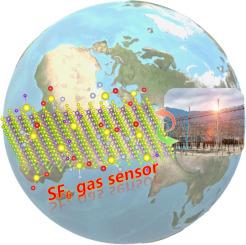当前位置:
X-MOL 学术
›
Comp. Mater. Sci.
›
论文详情
Our official English website, www.x-mol.net, welcomes your feedback! (Note: you will need to create a separate account there.)
Exploring Janus MoSSe monolayer as a workable media for SOF6 decompositions sensing based on DFT calculations
Computational Materials Science ( IF 3.3 ) Pub Date : 2021-01-01 , DOI: 10.1016/j.commatsci.2020.109976 Xiao-Yong Yang , Tanveer Hussain , John Per Albert Wärnå , Zhitong Xu , Rajeev Ahuja
Computational Materials Science ( IF 3.3 ) Pub Date : 2021-01-01 , DOI: 10.1016/j.commatsci.2020.109976 Xiao-Yong Yang , Tanveer Hussain , John Per Albert Wärnå , Zhitong Xu , Rajeev Ahuja

|
Abstract In modern electric systems, partial discharge (PD) or local overheating happens inevitably, leading to the SF6 insulated switchgears decomposition into several types of gas molecules. Thus, online monitoring these decomposition gases is considered as a promising way to detect PD to timely alarm and guarantee the safety operation of power equipments. Here, we propose recently synthesized Janus monolayer MoSSe as a superior gas sensing material by investigating the adsorption behaviors of SF6 decompositions, including H2S, SO2, SOF2 and SO2F2 on Janus surfaces by first-principles calculations. The adsorption patten of SF6 decompositions on MoSSe monolayer is: SO2 > SO2F2 > H2S > SOF2, in which all the absorptions exhibit physisorption. Besides, the binding strengths of the molecules adsorbed on S-layer are weaker than these on Se-layer due to the presence of out-of-plane polarization in Janus monolayer. While the adsorption strengths can be slightly enhanced by intrinsic S/Se vacancies or strain-driven of MoSSe monolayer. Importantly, the adsorption intensity can be modulated effectively by the applied electric fields. Furthermore, the response and desorption time of gas molecules on MoSSe monolayer are evaluated. With high gas sensitivity and selectivity towards SF6 decompositions, Janus MoSSe monolayer is demonstrated to be a promising material to be used in gas-insulated switch-gear (GIS) and constructed ultrahigh sensitivity nanodevices.
中文翻译:

基于 DFT 计算探索 Janus MoSSe 单层作为 SOF6 分解传感的可行介质
摘要 在现代电力系统中,不可避免地会发生局部放电(PD)或局部过热,导致SF6绝缘开关设备分解成多种气体分子。因此,在线监测这些分解气体被认为是检测局部放电及时报警并保证电力设备安全运行的一种很有前景的方法。在这里,我们通过第一性原理计算研究了 SF6 分解物(包括 H2S、SO2、SOF2 和 SO2F2)在 Janus 表面的吸附行为,提出了最近合成的 Janus 单层 MoSSe 作为优异的气敏材料。SF6 分解在 MoSSe 单层上的吸附模式为:SO2 > SO2F2 > H2S > SOF2,其中所有吸收都表现出物理吸附。除了,由于 Janus 单层中存在面外极化,吸附在 S 层上的分子的结合强度比在 Se 层上的要弱。而吸附强度可以通过固有的 S/Se 空位或 MoSSe 单层的应变驱动而略微增强。重要的是,吸附强度可以通过施加的电场有效地调节。此外,还评估了气体分子在 MoSSe 单层上的响应和解吸时间。凭借对 SF6 分解的高气体敏感性和选择性,Janus MoSSe 单层被证明是一种有前途的材料,可用于气体绝缘开关设备 (GIS) 和构建超高灵敏度纳米器件。而吸附强度可以通过固有的 S/Se 空位或 MoSSe 单层的应变驱动而略微增强。重要的是,吸附强度可以通过施加的电场有效地调节。此外,还评估了 MoSSe 单层上气体分子的响应和解吸时间。凭借对 SF6 分解的高气体敏感性和选择性,Janus MoSSe 单层被证明是一种有前途的材料,可用于气体绝缘开关设备 (GIS) 和构建超高灵敏度纳米器件。而吸附强度可以通过固有的 S/Se 空位或 MoSSe 单层的应变驱动而略微增强。重要的是,吸附强度可以通过施加的电场有效地调节。此外,还评估了气体分子在 MoSSe 单层上的响应和解吸时间。凭借对 SF6 分解的高气体敏感性和选择性,Janus MoSSe 单层被证明是一种有前途的材料,可用于气体绝缘开关设备 (GIS) 和构建超高灵敏度纳米器件。
更新日期:2021-01-01
中文翻译:

基于 DFT 计算探索 Janus MoSSe 单层作为 SOF6 分解传感的可行介质
摘要 在现代电力系统中,不可避免地会发生局部放电(PD)或局部过热,导致SF6绝缘开关设备分解成多种气体分子。因此,在线监测这些分解气体被认为是检测局部放电及时报警并保证电力设备安全运行的一种很有前景的方法。在这里,我们通过第一性原理计算研究了 SF6 分解物(包括 H2S、SO2、SOF2 和 SO2F2)在 Janus 表面的吸附行为,提出了最近合成的 Janus 单层 MoSSe 作为优异的气敏材料。SF6 分解在 MoSSe 单层上的吸附模式为:SO2 > SO2F2 > H2S > SOF2,其中所有吸收都表现出物理吸附。除了,由于 Janus 单层中存在面外极化,吸附在 S 层上的分子的结合强度比在 Se 层上的要弱。而吸附强度可以通过固有的 S/Se 空位或 MoSSe 单层的应变驱动而略微增强。重要的是,吸附强度可以通过施加的电场有效地调节。此外,还评估了气体分子在 MoSSe 单层上的响应和解吸时间。凭借对 SF6 分解的高气体敏感性和选择性,Janus MoSSe 单层被证明是一种有前途的材料,可用于气体绝缘开关设备 (GIS) 和构建超高灵敏度纳米器件。而吸附强度可以通过固有的 S/Se 空位或 MoSSe 单层的应变驱动而略微增强。重要的是,吸附强度可以通过施加的电场有效地调节。此外,还评估了 MoSSe 单层上气体分子的响应和解吸时间。凭借对 SF6 分解的高气体敏感性和选择性,Janus MoSSe 单层被证明是一种有前途的材料,可用于气体绝缘开关设备 (GIS) 和构建超高灵敏度纳米器件。而吸附强度可以通过固有的 S/Se 空位或 MoSSe 单层的应变驱动而略微增强。重要的是,吸附强度可以通过施加的电场有效地调节。此外,还评估了气体分子在 MoSSe 单层上的响应和解吸时间。凭借对 SF6 分解的高气体敏感性和选择性,Janus MoSSe 单层被证明是一种有前途的材料,可用于气体绝缘开关设备 (GIS) 和构建超高灵敏度纳米器件。


























 京公网安备 11010802027423号
京公网安备 11010802027423号